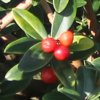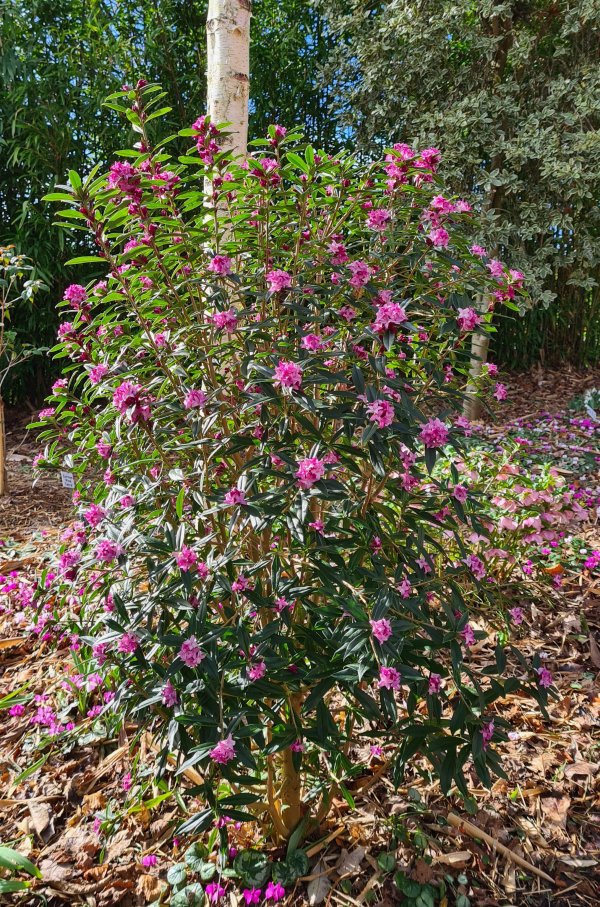| Daphne bholua 'Cobhay Coral' | Daphne bholua 'Penwood' |
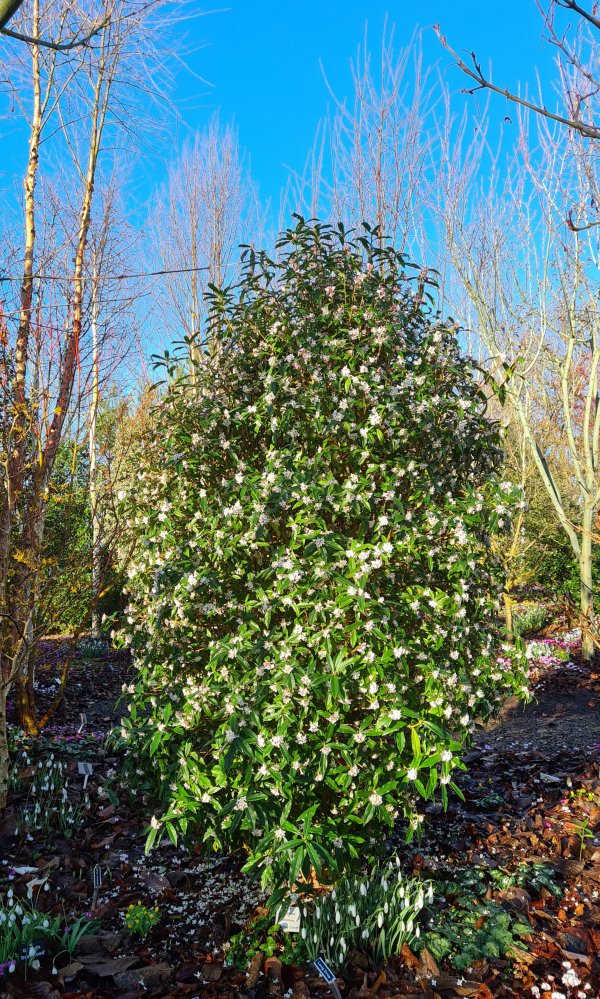 |
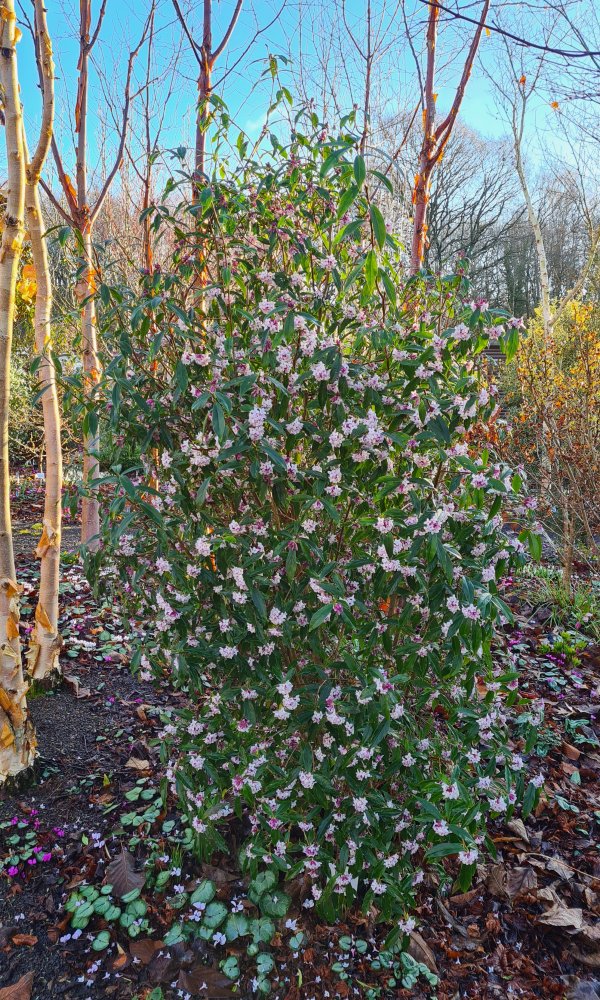 |
|
|
|
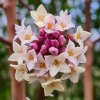 |
Daphne
sp. Originating at high altitude in northern Myanmar (previously Burma), this intriguing Daphne may even be a new species. However, in the meanwhile I am including it with the Daphne bholua cultivars since it is those which it most closely resembles. Supposedly evergreen in the wild, it is semi-evergreen for us here, though that is by no means a bad thing. Personally I would rather a plant dropped its leaves completely rather than hanging onto them when they look sad. Unusually, our experience here is that this one typically looses many of its leaves, whilst the few that remain stay a healthy deep green. When first introduced, there was uncertainty as to its hardiness, but we have had absolutely no problems with it here, even in our exposed site. Of course the other advantage of a winter-flowering plant loosing its leaves is that the flowers are fully visible in all their glory. The flowers of this one are at their best from late January through February, so a touch later than most of the D. bholua cultivars. They have the same form, with lots of small flowers held together in a globular head. They open sequentially from the outer ring inwards. This results in a rather wonderful colour gradient across the opening flowerhead. Dark purple in bud, they open paler to almost white, before maturing to a unique shade of cream which I have never otherwise seen in a D. bholua cultivar. The fabulous scent is also particularly pleasing, being (to my nose) a much lighter, fresher, citric fragrance than is typical for the D. bholua cultivars. Its habit also stands it apart. It is strong growing, typically forming a strong upright plant that is almost fastigiate, making it the perfect candidate to add some height to the winter garden without taking up too much width. In my opinion, this one has a great future. |
|
|
|
 |
Daphne bholua
'Cobhay Coral' Our own selection, this has quickly established itself as one of our favourites. It is a wonderful delicate coral pink in bud, opening paler to almost white. It has excellent vigour and makes a robust plant. It holds its foliage well through the winter, the leaves maintaining their rich green colour. |
|
|
|
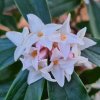 |
Daphne bholua
'Cobhay Debut' This was the first Daphne that we selected, from seed originating on the Daman Ridge in Nepal, and it's always the first in our collection to flower, always starting before Christmas. Prettily pink in bud (but not as darkly coloured as many), the flowers open to almost white. It is slow growing and compact, making a much smaller plant than is typical in this species. However, this lack of vigour does make it more vulnerable to weather extremes. If your site is more challenging therefore, or you would prefer a cultivar that is easier to please, then 'Cobhay Coral' shares similar colouring but is much more robust. |
|
|
|
 |
Daphne bholua
'Cobhay
Snow' Another of our own breeding, we selected this one for its pure white flowers. We previously grew a cultivar called 'Alba' which proved not to be as hardy as some and eventually succumbed. This selection is much more robust and grows extremely reliably. It is typically bushier and more free branching than some selections, with brighter green foliage. |
|
|
|
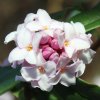 |
Daphne bholua
'Darjeeling' Originally grown from seed sent from Darjeeling in the 1960's, this selection is very much a classic expression of how Daphne bholua appears in the wild. Dark pink buds open to paler, sweetly scented flowers in mid winter. |
|
|
|
.jpg) |
Daphne bholua
'Garden House Enchantress'
|
|
|
|
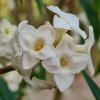 |
Daphne bholua
'Garden House Ghost'
|
|
|
|
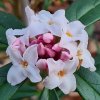 |
Daphne bholua
'Garden House Sentinel'
|
|
|
|
.jpg) |
Daphne bholua
'Jacqueline Postill' This is probably the best known selection, and it is indeed truly beautiful. The large flowers are deep purple-pink in bud, opening to much paler within. It originated as a seedling of 'Gurkha' in 1982, raised by Alan Postill, propagator at Hilliers. It can often grow strongly as a young plant, initially developing a more open habit. Don't be afraid to pinch back new growth to encourage it to bush. It is preferable to prune them a little and often rather than having to discipline an older specimen. |
|
|
|
 |
Daphne bholua
'Limpsfield' Roy Lancaster wrote a feature on Daphne bholua in the RHS journal The Garden some time ago, which was accompanied in the usual way by a plate showing a photographic comparison between flowers of the various cultivars. For me, this one stood out. It is visually closest to 'Jacqueline Postill' in flower, but I find that it retains its leaves more reliably. It is an excellent cultivar. |
|
|
|
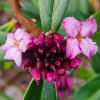 |
Daphne bholua
'Mary Rose' This fabulous recent selection has the darkest flowers of all Daphne bholua selections. Lots of them are dark in bud, but that sumptuous colour is retained in 'Mary Rose' as it opens. It is also one of the last to flower. It has particularly dark green foliage which is held well through the winter. Early indications are that it is more compact in habit, not getting as tall as most D. bholua selections. |
|
|
|
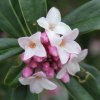 |
Daphne bholua
'Penwood' It has superb rich pink buds which open into large flower clusters in the usual way. We actually prefer this one to the popular 'Jacqueline Postill' because it holds its foliage so much better after flowering. We raised ‘Penwood' as a seedling from a plant of D. bholua acquired from Doug Harris at Penwood Nurseries many years ago, hence the name. Just one seedling came from the seed and it stood out for the dramatic contrast between the rich pink buds and the pink flushed flowers, much less purple than 'Jacqueline Postill'. It has an upright habit, being naturally bushier and more compact than 'Jacqueline Postill', with narrower leaves. The fragrance is equally superb. |
|
|
|
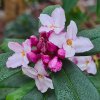 |
Daphne bholua
'Peter Smithers' Sir Peter Smithers was an amazing man. Born in 1913, he died in 2006 at the age of 92. He led an incredible life, but an interest in botany, gardening and horticulture remained at the heart of it, having been the first child to visit the Chelsea Flower Show, when he persuaded the RHS to allow him to do so at the age of 13. An intelligence officer during the war, he entered politics afterwards, becoming an MP in 1950. Following a spell as general secretary of the Council of Europe, he became a Swiss citizen, purchasing in 1970 an abandoned vineyard above Lake Lugano in Switzerland. He travelled widely collecting plants and created an internationally important plant collection and eco-system using some 10,000 plants designed to mature as he grew older and less able to maintain it. A truly remarkable man. It is fitting therefore that the Daphne that bears his name is a beauty. Flowering early in the season, with all the attributes that one would expect. |
|
|
|
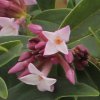 |
Daphne
'Spring Beauty' (D. sureil x D. bholua) D. sureil is closely allied to D. bholua, so this selection fundamentally resembles a wonderful D. bholua. If anything, this truly evergreen Daphne is even more gorgeous, with fabulous pink flowers, slightly later than the main flush of bholuas actually, which extends the display rather nicely. The flower heads are slightly less dense within themselves, creating a slightly more graceful appearance. Initially I was a touch concerned about its hardiness, but it is thriving for us, tolerating snow, wind and frost without a murmur. My favourite in the group (except for our home bred babies of course!) |
|
|
|
.jpg)
|
Daphne
'Cobhay
Purple Clouds' (D. wolongensis 'Guardsman' x D. bholua) This new Daphne and the next ('Cobhay Purple Pillar') are wonderful hybrids of our own breeding. They are intermediate between the parents in most respects. Thus, they start to flower a touch later than the bholuas, typically starting in late January and continuing well into February. The fragrant flowers are clustered all the way up the stems in the same way that is seen in 'Guardsman'. In habit they are an excellent compromise between their parents; upright in habit, particularly when young, being bushier and less stiffly upright than 'Guardsman' whilst remaining smaller than is normal for a bholua. They really are perfect garden plants, tolerant of a wide range of conditions but thriving in light shade. The two hybrids are similar but subtly different. This one is slightly more compact with a tighter habit. Both have bright pinkish purple flower buds that fade to white from the middle as they mature. The colour of this hybrid is a slightly redder shade of purple. |
|
|
|
 |
Daphne
'Cobhay
Purple Pillar' (D. wolongensis 'Guardsman' x D. bholua) This lovely new Daphne is the sister seedling of 'Cobhay Purple Clouds' described above. This one develops a slightly looser habit as it matures, and the flowers are slightly more purple in colour, lacking the reddish tones that I see in 'Cobhay Purple Clouds'. |
|
|
|
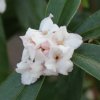 |
Daphne
'Spring Herald' (D. acutiloba x D. bholua) The name really sums it up! When this one flowers, we know that the winter is almost behind us and the days are lengthening. Almost pure white flowers stud this lovely evergreen shrub, filling the air with a delicious spicy perfume. The acutiloba influence makes this one more compact in habit than most selections of D. bholua. The flowers are a little smaller than those of the bholuas. |
|
|
|
| Other Daphne |
|
|
|
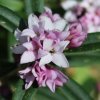
|
Daphne
'Cobhay Pink Delight' (D. tangutica x D. wolongensis 'Guardsman') This is another lovely selection of our own breeding. The influence of 'Guardsman' can be seen in the way in which the flowers are clustered along the length of each stem, creating a veritable pillar of flower. As with many daphnes, it flowers over a long period of time, typically peaking in April-May. It is intermediate in habit between its parents, being more robust than the somewhat straggly 'Guardsman' but taller and more upright than D. tangutica. The flowers are a delightful pale pink, being only a little darker in bud. It grows in full exposure here, where it does loose most of its leaves to the winter gales. In a more sheltered site, surrounded by other planting, it is evergreen. |
|
|
|
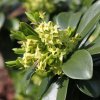 |
Daphne pontica
hybrid (D. pontica x D. laureola) We originally acquired this as D. pontica, but it soon became apparent that it is in fact a hybrid with D. laureola. It's a fabulous plant though, and rather intermediate between its parents, ending up better than them both! It forms a dense mound of comparatively large, evergreen foliage that looks good all year. The showy greeny yellow flowers are produced in large clusters in April and are sweetly scented. |
|
|
|

|
Daphne tangutica This Chinese species is arguably the easiest Daphne to grow and the best summer flowering species. The first flowers tend to be seen in April, with the display peaking in May. It then continues flowering sporadically according to the weather, potentially right through until November. The flowers are very much classic Daphne; dark pink in bud, opening to almost white. They are pollinated by moths, so their sweet fragrance is most noticeable in the evening. D. tangutica makes a medium sized evergreen shrub, growing comparatively slowly to perhaps 1m tall by a little wider. It will grow happily in a sunny site if the soil is adequately moisture retentive in summer. If drying out is likely to be an issue, then a shady site will be better. |
|
|
|
.jpg)
.jpg)
